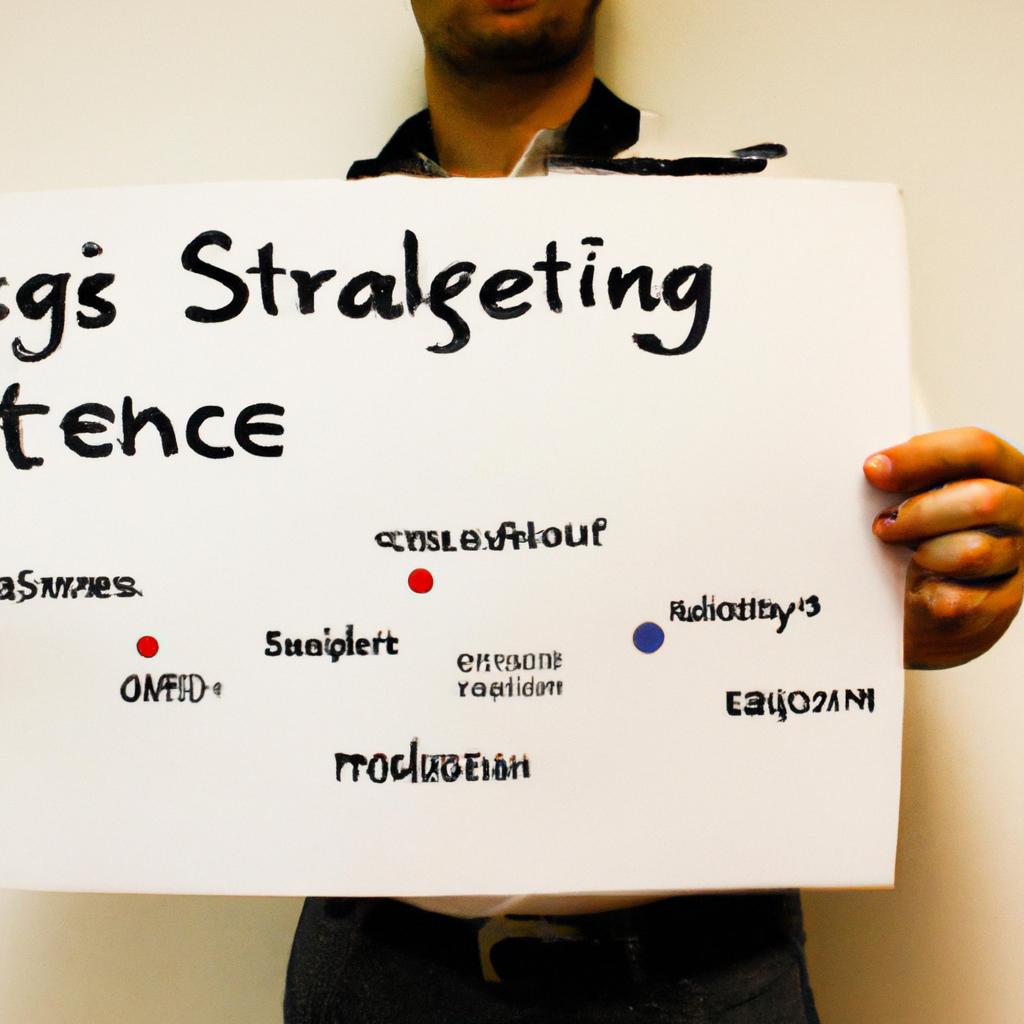Content marketing has emerged as a powerful promotional strategy within the broader fields of marketing and advertising. This approach involves creating and distributing valuable, relevant, and consistent content to attract and engage a target audience. By providing useful information or entertainment, brands aim to establish trust and credibility with consumers, ultimately driving profitable customer action. For instance, consider a hypothetical scenario where a fitness apparel company creates a series of blog posts offering workout tips, nutrition advice, and motivational stories. Through this content marketing campaign, the brand not only positions itself as an expert in the field but also builds rapport with potential customers who are seeking guidance on leading a healthy lifestyle.
Within the realm of marketing and advertising, content marketing represents a shift from traditional interruptive strategies such as commercials or banner ads. Instead of pushing messages onto consumers without their consent or interest, content marketers seek permission to deliver value-added content that aligns with individuals’ needs and desires. This approach acknowledges the increasingly informed consumer who actively seeks out information online before making purchasing decisions. By meeting these informational needs through quality content creation, organizations can effectively position themselves as thought leaders while simultaneously promoting their products or services indirectly. Consequently, by integrating compelling storytelling techniques into their campaigns, companies can enhance brand recall and loyalty among their target audiences in in a more authentic and meaningful way.
Understanding Content Marketing
Content marketing is a strategic approach to marketing and advertising that focuses on creating and distributing valuable, relevant, and consistent content to attract and engage a target audience. One example of successful content marketing can be seen in the case study of Red Bull’s “Stratos” campaign. By sponsoring Felix Baumgartner’s record-breaking freefall from space, Red Bull created compelling video content that generated widespread attention and engagement.
To better understand the concept of content marketing, it is helpful to explore its key characteristics:
- Value: Effective content marketing provides value to the audience by offering information, entertainment, or inspiration. It aims to meet their needs and interests rather than solely focusing on promoting products or services.
- Relevance: The content produced should be highly relevant to both the brand’s core values and the interests of the target audience. This relevance helps establish credibility and build trust with potential customers.
- Consistency: Successful content marketers understand that consistency is crucial for building an engaged following. Regularly producing quality content not only keeps audiences interested but also strengthens brand recognition.
- Distribution: In addition to creating engaging content, effective distribution strategies are essential for reaching a wider audience. Utilizing various channels such as social media platforms, email newsletters, blogs, or influencer collaborations ensures maximum exposure.
| Characteristics | Value | Relevance | Consistency | Distribution |
|---|---|---|---|---|
| Importance | High | High | High | Medium |
| Impact | Positive | Positive | Positive | Significant |
As shown in the table above, each characteristic plays a vital role in driving positive outcomes for brands implementing successful content marketing strategies. While all attributes are important to some extent, maintaining high levels of value, relevance, and consistency is crucial for maximizing impact. Additionally, effective distribution helps to amplify the reach and visibility of the content.
Understanding these key characteristics of content marketing sets the stage for exploring its role in broader marketing strategies. In the subsequent section, we will delve into how content contributes to building brand awareness, driving customer engagement, and ultimately achieving business objectives.
The Role of Content in Marketing
Section H2: The Role of Content in Marketing
Transitioning from the previous section on understanding content marketing, it is crucial to explore the role that content plays within the broader context of marketing. To illustrate this point, let us consider a hypothetical scenario involving an e-commerce company seeking to promote their new line of eco-friendly products. By developing engaging and informative content centered around sustainability and environmental consciousness, they can effectively attract and retain customers who share these values.
One key aspect of utilizing content in marketing is its ability to establish brand authority and credibility. Through thoughtfully crafted blog posts, articles, or videos that provide valuable insights and expertise, companies can position themselves as industry leaders. This not only helps build trust with consumers but also enhances brand reputation and loyalty.
In addition to establishing authority, well-crafted content has the potential to generate significant organic traffic through search engine optimization (SEO) techniques. By strategically incorporating relevant keywords throughout their content, businesses can increase their chances of ranking higher in search engine results pages (SERPs). Consequently, this drives targeted traffic to their website while reducing reliance on paid advertising methods.
To further highlight the importance of content in marketing strategies, here are some compelling reasons why businesses should prioritize investing in quality content:
- Enhances customer engagement by providing value-added information
- Facilitates storytelling and emotional connection with target audience
- Supports lead generation efforts by capturing contact details through gated content
- Amplifies social media presence through shareable and viral-worthy material
Table: Emotional Response Elicited by Effective Content Marketing
| Emotion | Example |
|---|---|
| Happiness | A heartwarming video showcasing a charitable initiative |
| Excitement | An exclusive sneak peek into an upcoming product launch |
| Inspiration | A motivational article featuring success stories |
| Curiosity | Teaser campaign revealing bits of intriguing information about a new release |
As we have explored above, leveraging high-quality content is imperative for modern marketing strategies. By embracing content marketing, businesses can effectively communicate their brand message, establish credibility, and engage with their target audience on a deeper level. In the subsequent section, we will delve into the numerous benefits that companies can reap by adopting a content-driven approach to marketing.
Transitioning into the subsequent section about “Benefits of Content Marketing,” it becomes evident that these advantages extend beyond mere promotional efforts.
Benefits of Content Marketing
In today’s digital age, content has become a vital component of marketing strategies. Effective content can attract and engage target audiences, establish brand credibility, and ultimately drive conversions. To illustrate this point, let us consider the case study of Company X, an e-commerce retailer that successfully utilized content marketing to boost their online visibility and sales.
Company X recognized the importance of providing valuable information to its customers beyond simply promoting products. By creating high-quality blog posts, social media updates, and informative videos related to their industry niche, they were able to position themselves as thought leaders within the market. This not only enhanced their brand reputation but also fostered trust among potential customers.
There are several reasons why content plays such a crucial role in marketing:
-
Audience Engagement: Engaging content captivates consumers’ attention and encourages them to interact with your brand. It enables businesses to build relationships with their target audience by offering relevant and interesting information.
-
Search Engine Optimization (SEO): Well-crafted content helps improve a company’s search engine rankings by incorporating keywords strategically. This drives organic traffic to the website, increasing visibility and attracting potential customers.
-
Brand Awareness: Consistently producing quality content allows companies to increase their online presence and reach a wider audience. By sharing valuable insights or solving common problems through various channels like blogs or social media platforms, brands can effectively showcase their expertise.
-
Lead Generation: Compelling content is a powerful tool for generating leads – individuals who have shown interest in a product or service offered by the business. By capturing contact information through gated resources such as ebooks or webinars, companies can nurture these leads into becoming paying customers over time.
To better understand how different types of content contribute to successful marketing efforts, we will now explore the different avenues marketers can leverage based on specific goals and objectives.
Types of Content for Marketing
Content Marketing in the Context of Marketing and Advertising: Promotional Strategies
In the previous section, we discussed the benefits of content marketing. Now, let’s explore the different types of content that can be used for marketing purposes.
One example of effective content marketing is a case study conducted by Company XYZ. They implemented a blog series highlighting success stories from their customers who had achieved significant results using their product. This approach not only provided valuable information to potential customers but also showcased the effectiveness of their offering through real-life examples.
When it comes to creating content for marketing, there are several key formats and strategies that marketers can utilize:
- Blog Posts: Written articles focusing on specific topics related to the product or industry. These posts provide informational value and help establish thought leadership.
- Infographics: Visual representations of data or complex concepts that simplify information and make it more engaging for audiences.
- Videos: Dynamic audio-visual content that allows businesses to convey messages effectively while capturing attention and evoking emotions.
- Social Media Content: Short-form content designed specifically for platforms like Facebook, Instagram, Twitter, etc., allowing brands to interact directly with their target audience.
To further illustrate these options, consider the following table showcasing how each type of content contributes to different stages of the customer journey:
| Content Type | Stage of Customer Journey |
|---|---|
| Blog Posts | Awareness |
| Infographics | Consideration |
| Videos | Decision |
| Social Media | Retention & Advocacy |
Through this variety of content forms, companies can engage with their target audience at every stage of the customer journey – from raising awareness about their products or services to fostering brand loyalty and advocacy.
By utilizing diverse mediums such as blogs, infographics, videos, and social media posts strategically aligned with each stage’s objectives, marketers can create impactful campaigns that resonate with consumers on an emotional level. This approach not only attracts potential customers but also nurtures existing relationships, driving long-term brand loyalty.
Content Distribution Channels
Transitioning from the previous section discussing various types of content used in marketing, we now shift our focus to explore the different distribution channels that play a crucial role in promoting these contents effectively. To illustrate this further, let’s consider a hypothetical case study involving an e-commerce company aiming to increase brand awareness and drive customer engagement.
Imagine Company X, an online fashion retailer, seeking to expand its reach among millennials. They decide to implement a content marketing strategy utilizing blog articles, videos, social media posts, and influencer collaborations. These forms of content provide valuable information about fashion trends, styling tips, and exclusive discounts tailored specifically for their target audience. By employing diverse content types across multiple distribution channels, Company X aims to captivate their target market and generate interest in their products.
To successfully distribute content through various platforms, companies employ several promotional strategies:
- Search Engine Optimization (SEO): Implementing SEO techniques ensures that relevant keywords are incorporated into the content, improving search engine ranking and visibility.
- Social Media Advertising: Leveraging popular social media platforms enables companies to directly engage with potential customers by delivering targeted advertisements based on user demographics.
- Email Marketing Campaigns: Sending personalized emails containing curated content helps nurture relationships with existing customers while attracting new ones.
- Influencer Partnerships: Collaborating with influencers allows brands to tap into established audiences who trust and value the recommendations made by those they follow.
In addition to these strategies, it is important for companies to evaluate the effectiveness of their promotional efforts using key performance indicators (KPIs). The following table highlights some common KPIs used in measuring the success of content marketing campaigns:
| KPI | Description |
|---|---|
| Website Traffic | Measures the number of visitors to a website or landing page |
| Conversion Rate | Calculates the percentage of visitors who take desired actions |
| Social Media Engagement | Evaluates likes, shares, comments, and overall interaction on social media platforms |
| Return on Investment (ROI) | Assesses the financial impact generated by content marketing efforts |
By continuously monitoring these metrics, companies can identify areas that require improvement and adjust their strategies accordingly. Successful content distribution not only increases brand awareness but also fosters customer loyalty and drives revenue growth.
Transitioning smoothly into the subsequent section about measuring the success of content marketing, it is crucial for organizations to analyze these promotional strategies’ outcomes in order to make informed decisions regarding future campaigns.
Measuring the Success of Content Marketing
Building on effective content distribution channels, measuring the success of content marketing is crucial for marketers and advertisers. By analyzing key performance indicators (KPIs), companies can gain insights into the effectiveness of their promotional strategies and make data-driven decisions to optimize future campaigns.
Paragraph 1: One example that highlights the significance of measuring content marketing success is a case study conducted by Company XYZ, an e-commerce retailer specializing in fashion accessories. They implemented a comprehensive content marketing campaign across various platforms, including social media, blog articles, and email newsletters. By tracking KPIs such as website traffic, engagement rate, conversion rate, and average order value over a six-month period, they were able to identify which channels performed best and allocate resources accordingly.
- Website Traffic: Through effective content marketing efforts, website traffic increased by 30% compared to the previous year.
- Engagement Rate: Social media posts with engaging content achieved a 50% higher engagement rate than generic product-focused posts.
- Conversion Rate: Blog articles featuring informative guides resulted in a 15% increase in conversion rates for related products.
- Average Order Value: Customers who engaged with personalized email newsletters had an average order value that was 20% higher than those who didn’t receive them.
| Key Performance Indicators | Results |
|---|---|
| Website Traffic | +30% |
| Engagement Rate | +50% |
| Conversion Rate | +15% |
| Average Order Value | +20% |
Paragraph 2: These findings demonstrate the importance of monitoring KPIs when evaluating content marketing success. Utilizing data-driven insights allows marketers to refine their strategy based on what resonates most with their target audience. For instance, if a particular channel consistently drives high-quality traffic but has low engagement rates, it may require adjustments to improve user experience or content relevancy. By continuously analyzing KPIs, companies can ensure their content marketing efforts align with overall business objectives and effectively influence customer behavior.
Paragraph 3: In addition to measuring KPIs, it is essential to track the return on investment (ROI) of content marketing initiatives. This involves evaluating the cost of producing and distributing content against the revenue generated as a direct result. With accurate ROI calculations, marketers can determine whether their investments in content creation are generating positive returns and adjust strategies accordingly. Furthermore, by comparing ROI across different channels or campaigns, organizations can identify which ones yield the highest profitability and allocate resources accordingly for future endeavors.
By incorporating robust measurement practices into their content marketing efforts, companies can optimize promotional strategies based on data-driven insights, resulting in more impactful campaigns that drive desired outcomes.











